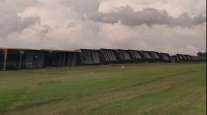Hundreds of Barges Stalled as Floods Hinder Midwest Supplies

[Stay on top of transportation news: Get TTNews in your inbox.]
Hundreds of barges are stalled on the Mississippi River, clogging the main circulatory system for a farm-belt economy battered by a relentless, record-setting string of snow, rainstorms and flooding.
Railways and highways have been closed as well, keeping needed supplies from farmers and others, and limiting the crops sent to market. For Chris Boerm, who manages transportation for Archer-Daniels-Midland Co., one of the nation’s largest agricultural commodities dealers, the weather is an unyielding, ever-changing challenge.
He and his co-workers spend time carefully planning out the quickest way to get supplies to the people that need them, he said. But it’s tough staying ahead of the drenching rain.
“It’s sort of like Mike Tyson’s quote, everybody’s got a plan until you get punched in the face, right?” Boerm said by telephone. “Every day we come in and we’ve got a plan. But then it rains three inches somewhere overnight where it wasn’t expected, and the plan changes.”
That means supplies they plan to move on one river may need to be rerouted to a different waterway, or offloaded onto a rail car or a truck, with the hope they won’t be delayed by the weather as well. For instance, when water reaches the wheel bearings on a freight car in a siding, it can’t be hauled long distances without an inspection, yet another potential delay.
Flooding in America is getting more frequent and severe — and climate change is driving it. In some parts of the Midwest and East Coast, extreme rain has already increased by more than 50 percent since the early 1900s. pic.twitter.com/fM7piGh96p — NPR (@NPR) June 7, 2019
At just two locks along the upper Mississippi, almost 300 barges are being held in place as a result of high water and fast currents, according to Waterways Council Inc., which tracks barge movements. And hundreds more are waiting in St. Louis, Cairo, Ill., and Memphis, Tenn., said Deb Calhoun, the council’s senior vice president.
“It’s a big bottleneck,” Calhoun said.
The contiguous U.S. had its wettest January to May on records dating back to 1895, according to the U.S. National Centers for Environmental Information in Asheville, N.C. Nebraska, Kansas and Missouri had their rainiest May on record, the center’s data shows, while Arkansas, Oklahoma, South Dakota, Wisconsin and Illinois were all in the top 10.
While the rain will ease in the next few days across the central U.S., the deluge will get started again next week, Don Keeney, senior agricultural meteorologist at Maxar in Gaithersburg, Md., said in a telephone interview.
As of June 10, 203 points along U.S. rivers were at flood stage, the majority of those on the Mississippi, Arkansas, and Missouri Rivers and their tributaries, according to the National Weather Service. The Mississippi at Baton Rouge is forecast to rise about another foot this week, withing less than two feet of its record crest in 1927.

(Daniel Acker/Bloomberg News)
While high waters stop barge traffic, they also carry other dangers. Flood waters have closed off Interstate highways on a number of occasions and water itself. That overwhelms farm fields, sewer and septic systems and industrial plants along its banks, which can become quite toxic as it flows away from the river beds.
“We dealt with a wet fall, and then record snowfall in many places,” said Tim Eagleton, senior engineering specialist for FM Global, an industrial insurer. “Of course, all that melts and comes down the Mississippi. Not only that, but we have had 200%-plus rainfall over a large part of that basin for months, and then a record-wet May in a lot of places.’
The bottom line, according to Eagleton: “Very long duration flooding on the Mississippi River that can really start to wear on people.” Almost 200 miles of the Mississippi has been shut down, he said.
Iowa corn farmer Bob Hemesath, whose farm is about 35 miles west of the Mississippi River in Decorah, had planned to deliver about 20,000 bushels of corn to a Bunge Ltd. facility in McGregor in March and April. Instead, he ended up sending the grain to a local ethanol plant because the facility was closed due to high water levels and still remains shuttered.

Barges sit along the flooded Mississippi River (Daniel Acker/Bloomberg News)
He knows neighboring soybean farmers who are waiting to send their crops down the river as well. U.S. farmers still hold a lot of crops in their silos from their 2018 harvest because selling hasn’t made financial sense during the U.S.-China trade war, slow demand and slumping prices. Now, with northbound and southbound river traffic stalled, Hemesath is worried about what the barge backlog is going to look like this fall.
“We are going to be missing almost three months of river traffic, I don’t even know how we will get caught up,” he said. “If the river facilities don’t have barges that are caught up on old crop they won’t be able to ship new crop. It’s another stress for farmers.”
Among Boerm’s worries is that with the water levels so high — and for so long — there isn’t a lot of visibility yet on what the long-term impact to the waterways may be.
Boerm was an ADM manager in 1993, when more than 17 million acres were flooded across nine states in June through August. He recalls working with the Red Cross in Hardin, Ill., sandbagging the bloated waterways and helping evacuate homes. The recent flooding is just as formidable a beast, he said.




